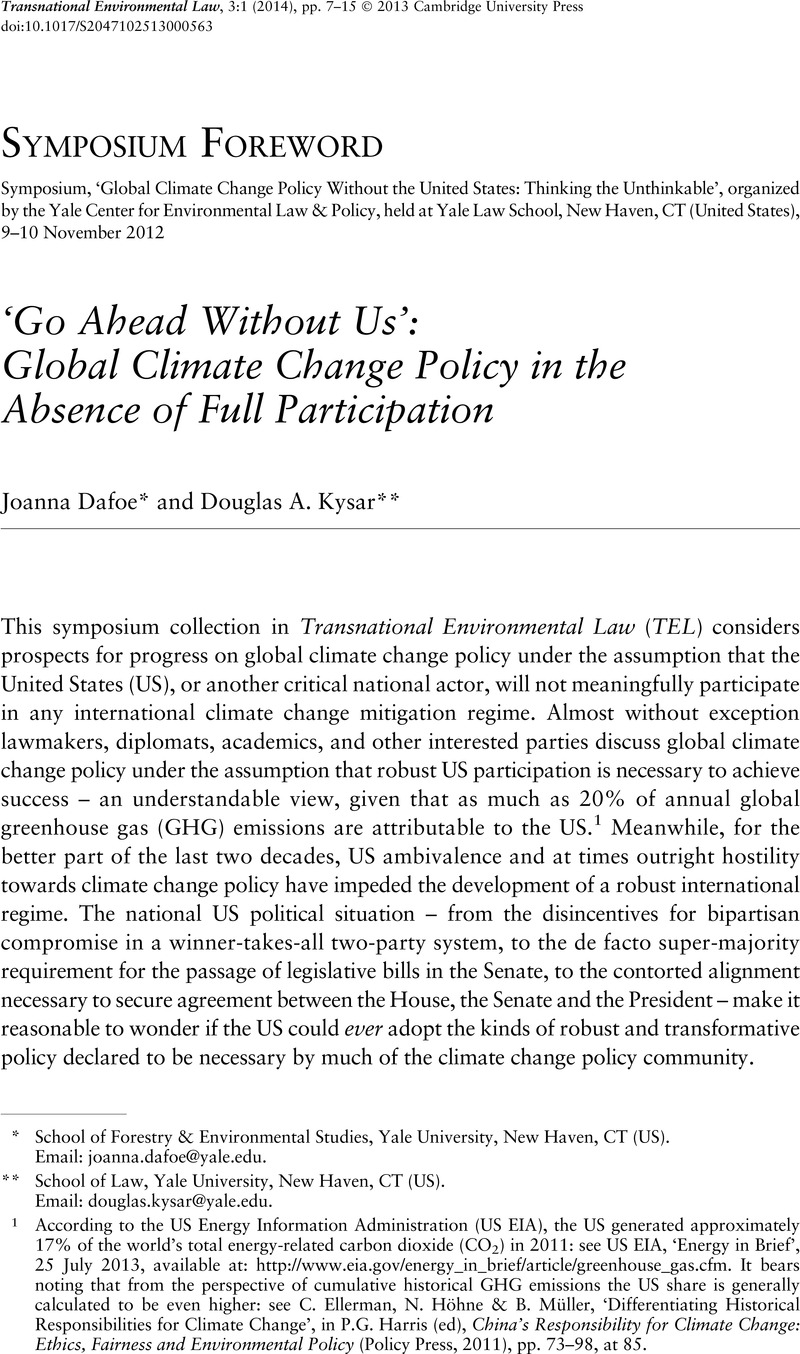Article contents
Symposium Foreword: ‘Go Ahead Without Us’: Global Climate Change Policy in the Absence of Full Participation
Published online by Cambridge University Press: 16 April 2014
Abstract

- Type
- Symposium: Global Climate Governance Without The Us
- Information
- Copyright
- Copyright © Cambridge University Press 2013
References
1 According to the US Energy Information Administration (US EIA), the US generated approximately 17% of the world’s total energy-related carbon dioxide (CO2) in 2011: see US EIA, ‘Energy in Brief’, 25 July 2013, available at: http://www.eia.gov/energy_in_brief/article/greenhouse_gas.cfm. It bears noting that from the perspective of cumulative historical GHG emissions the US share is generally calculated to be even higher: see Ellerman, C., Höhne, N. & Müller, B., ‘Differentiating Historical Responsibilities for Climate Change’, in Harris, P.G. (ed), China's Responsibility for Climate Change: Ethics, Fairness and Environmental Policy (Policy Press, 2011), pp. 73–98, at 85.Google Scholar
2 L. Friedman, ‘Overseas Frustration Grows over U.S. Domestic Impasse on Climate Policy’, Environment & Energy Publishing, 3 Aug. 2010, available at: http://www.eenews.net/stories/93960.
3 See, e.g., Barrett, S. & Stavins, R., ‘Increasing Participation and Compliance in International Climate Change Agreements’ (2003) 3(4) International Environmental Agreements: Politics, Law and Economics, pp. 349–76CrossRefGoogle Scholar; Olmstead, S.M. & Stavins, R.N., ‘Three Key Elements of a Post-2012 International Climate Policy Architecture’ (2012) 6(1) Review of Environmental Economics and Policy, pp. 65–85CrossRefGoogle Scholar; Aldy, J.E. & Stavins, R.N. (eds), Post-Kyoto International Climate Policy: Implementing Architectures for Agreement (Cambridge University Press, 2010).Google Scholar
4 The White House, Office of the Press Secretary, ‘Remarks by the President in the State of the Union Address’, 12 Feb. 2013, available at: http://www.whitehouse.gov/the-press-office/2013/02/12/remarks-president-state-union-address.
5 Executive Office of the President, ‘The President’s Climate Action Plan’, June 2013, available at: http://www.whitehouse.gov/sites/default/files/image/president27sclimateactionplan.pdf.
6 US Department of State, ‘US-China Climate Change Working Group Fact Sheet’, 10 July 2013, available at: http://www.state.gov/r/pa/prs/ps/2013/07/211768.htm.
7 As President Obama remarked in his State of the Union address (n. 4 above): ‘If Congress won’t act soon to protect future generations, I will. I will direct my Cabinet to come up with executive actions we can take, now and in the future, to reduce pollution, prepare our communities for the consequences of climate change, and speed the transition to more sustainable sources of energy.’ See also The White House, Office of the Press Secretary, ‘Remarks by the President on Climate Change’, 25 June 2013, available at: http://www.whitehouse.gov/the-press-office/2013/06/25/remarks-president-climate-change.
8 M. Gerrard & S. Welton, ‘US Federal Climate Change Law in Obama's Second Term’ (2014) 3(1) Transnational Environmental Law, pp. 111–125.
9 Kyoto Protocol to the United Nations Framework Convention on Climate Change, Kyoto (Japan), 11 Dec. 1997, in force 16 Feb. 2005, available at: http://unfccc.int. See Metz, B., ‘The Legacy of the Kyoto Protocol: A View from the Policy World’ (2013) 4(3) Wiley Interdisciplinary Reviews: Climate Change, pp. 151–8, at 154Google Scholar; and Decision 1/CMP.8, ‘Amendment to the Kyoto Protocol pursuant to its Article 3, paragraph 9 (the Doha Amendment)’, UN Doc. FCCC/KP/CMP/2012/13/Add.1, 28 Feb. 2013, available at: http://unfccc.int/resource/docs/2012/cmp8/eng/13a01.pdf#page=2.
10 U.S. Conference of Mayors Climate Protection Agreement, 2005, available at: http://www.usmayors.org/climateprotection/agreement.htm.
11 The RGGI is a cooperative effort among the states of Connecticut, Delaware, Maine, Maryland, Massachusetts, New Hampshire, New York, Rhode Island, and Vermont to cap and reduce CO2 emissions from the power sector: see http://www.rggi.org.
12 National Research Council, America’s Climate Choices (The National Academies Press, 2011), pp. 12–3.
13 Office of Governor Edmund G. Brown Jr., ‘Photo Release: Governor Brown Expands Partnership with China to Combat Climate Change’, 13 Sept. 2013, available at: http://gov.ca.gov/news.php?id=18205.
14 See Farber, D.A., ‘Climate Policy and the United States System of Divided Powers: Dealing with Carbon Leakage and Regulatory Linkage’ (2014) 3(1) Transnational Environmental Law, pp. 31–55Google Scholar; and Abbott, K.W., ‘Strengthening the Transnational Regime Complex for Climate Change’ (2014) 3(1) Transnational Environmental Law, pp. 57–88.Google Scholar
15 United Nations Framework Convention on Climate Change, New York, NY (US), 9 May 1992, in force 21 Mar. 1994, available at: http://unfccc.int.
16 Video recordings of the conference proceedings are available at: http://envirocenter.yale.edu/climate2012/recordings.
17 Beck, S. & Burleson, E., ‘Inside the System, Outside the Box: Palau’s Pursuit of Climate Justice and Security at the UN’, (2014) 3(1) Transnational Environmental Law, pp. 17–29.Google Scholar
18 D.A. Kysar, ‘Climate Change and the International Court of Justice’, 14 Aug. 2013, p. 8, available at: http://ssrn.com/abstract=2309943.
19 Ibid., at p. 11.
20 The Ad Hoc Working Group on the Durban Platform for Enhanced Action (ADP) was established to develop a ‘protocol, another legal instrument or an agreed outcome with legal force under the Convention applicable to all Parties’: see Decision 1/CP.17, ‘Establishment of an Ad Hoc Working Group on the Durban Platform for Enhanced Action’, UN Doc. FCCC/CP/2011/9/Add.1, 15 Mar. 2012, available at: http://unfccc.int/resource/docs/2011/cop17/eng/09a01.pdf.
21 Geneva (Switzerland), 30 Oct. 1947, in force 1 Jan. 1948 , available at: http://www.wto.org/english/docs_e/legal_e/gatt47_e.pdf.
22 Farber, n. 14 above.
23 Abbott, n. 14 above.
24 Farber, n. 14 above, at p. 31.
25 Abbott, n. 14 above, at p. 59.
26 Stewart, R.B., Oppenheimer, M. & Rudyk, B., ‘Building Blocks for Global Climate Protection’ (2013) 32 Stanford Environmental Law Journal, pp. 341–92.Google Scholar
27 Parson, E.A., ‘Climate Engineering in Global Climate Governance: Implications for Participation and Linkage’ (2014) 3(1) Transnational Environmental Law, pp. 89–110.Google Scholar
28 Ibid., at p. [XXX].
29 These are two of the five recommendations offered by the Bipartisan Policy Center Task Force on Climate Remediation Research: see Bipartisan Policy Center, Task Force on Climate Remediation Research, ‘Geoengineering: A National Strategic Plan for Research on the Potential Effectiveness, Feasibility, and Consequences of Climate Remediation Technologies’, 4 Oct. 2011, pp. 12 and 19, available at: http://bipartisanpolicy.org/sites/default/files/BPC%20Climate%20Remediation%20Final%20Report.pdf
30 Socolow, R., ‘Positions from Projections: Views from the Yale Community on Issues in Ecology’ (1970) 33(8) Yale Alumni Magazine, pp. 1–73, at 54.Google Scholar
- 1
- Cited by




